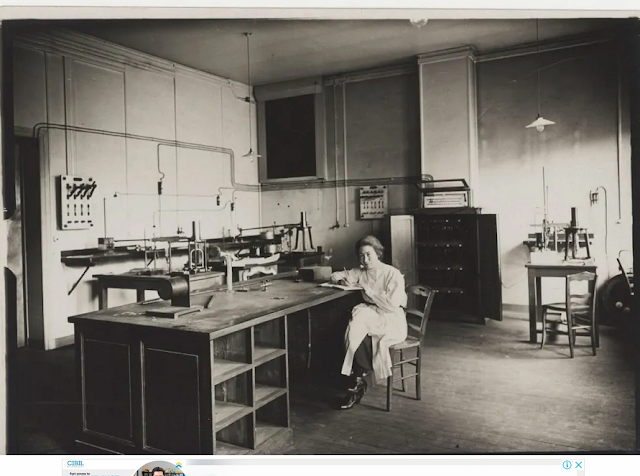- Google Doodle celebrates the 140th birth anniversary of Stefania Maracinenu
- Romanian physicist studying radioactivity
- Her experiments provided the first example of artificial radioactivity.
The Google Doodle for June 18th celebrates the 140th birth anniversary of Romanian physicist Stefania Maracinenu. It artistically shows him working in a laboratory.
Who was Stefania Maracinenu? Google Doodle celebrates 140th birth anniversary of Romanian physicist
Maracineanu was one of the leading women in the discovery and research of radioactivity. Born in Bucharest on June 18, 1882, Marcinenu graduated in 1910 with a degree in physical and chemical sciences. She began her career as a teacher at the Central School for Girls in Bucharest but earned a scholarship from the Romanian Ministry of Science while working. Work.
She then decided to pursue graduate research at the Radium Institute in Paris. At the time, the institute was under the direction of Nobel Prize-winning physicist Marie Curie and became a worldwide center for the study of radioactivity.
Maracineanu earned his Ph.D. Researching polonium, Curie discovered this element.
In the course of his research, Romanian discovered that the half-life depends on the type of metal it was placed on. They investigated whether the alpha rays from polonium had managed to transfer some of the metal atoms to radioactive isotopes. This research eventually led to the first example of artificial radioactivity.
 |
| image credit-https://khabaremi.com |
Maracineanu earned his Ph.D. To complete his graduation enrolled at Sorbonne University in Paris. in Physics. He achieved this feat in two years. Then, the Romanian scientist worked for four years at the Astronomical Observatory in Medone, before returning to her homeland and establishing his first laboratory to study radioactivity.
Part of her research interest also leaned toward studying artificial rain, and Maracineanu traveled to Algeria to test the results. She also found a link between earthquakes and rainfall, suggesting that during earthquakes there is a significant increase in radioactivity at the epicenter of the earthquake.
While Maracineanu did not receive much global recognition for her work, the Romanian Academy of Sciences was aware of her contribution and selected the physicist as research director.
She died of cancer in 1944, reportedly from radiation exposure.
Maracinenu, Stefania (1882 – 1944)
In danger of being unjustifiably forgotten among Romanian scientists of the past, there is a woman, the world’s first prominent physicist: Stefania Morecinenu. Nevertheless, here about her, Marie Curie wrote: “Miss Moricianu worked in my laboratory for many years and recently received her PhD in physics. I especially appreciate her scientific work.
As you know, natural radioactivity, discovered by Henri Becquerel in 1896, is the property of atomic nuclei to spontaneously disintegrate by the emission of alpha, beta and gamma radiation. Artificial radioactivity occurs after the bombardment of stable nuclei with neutrons or accelerated particles. Working on her Ph.D thesis on the polonium constant (1924), tefania Mărăcineanu observed such a phenomenon: the metal lead-in supports of the devices are affected by radioactive polonium, which in its turn begins to emit radiations, which are similar to those of polonium. Remains even after not working!
Nearly a decade after the initial discovery, Frédéric and Irene Joliot-Curie had to obtain artificial radioactivity by bombarding aluminum with alpha particles, the metal continuing to disintegrate after the alpha radiation source was removed.
Both scientists have given an explanation of the whole phenomenon of artificial radioactivity, their discovery being awarded the Nobel Prize; We believe that Romanian physicists would deserve to be associated, as the phenomenon was first identified. And much more, as Irene Juliet-Curie herself admitted in an article in the “News Wiener Journal” (5 June 1934): “We remember that the Romanian scientist, Miss Morecinenu, announced the discovery of artificial radioactivity in 1924. did.”
Early life introduction
Tefania Mărăcineanu was born on June 18, 1882 in Bucharest. She had a troubled childhood, which did not like to speak, but it stamped her entire existence. In 1910 she received a degree in chemical physics and soon became a teacher at the Central School for Girls in Bucharest. After World War I, she went to Paris to specialize, where she worked at the Radium Institute under Marie Curie and then at the Astronomical Observatory of Meudon; She published several papers in prestigious scientific journals from 1919 to 1930. In 1925 she was appointed assistant to the Faculty of Science in Bucharest, where she organized the first radioactivity laboratory in Romania, doing original work in this area.
She had interesting experiences at home and abroad in obtaining artificial rain, using radioactive salts, and achieving some results (Sahara at Brigan, etc.). She published valuable works regarding the link between earthquakes and precipitation and was the first to report that the release of radioactive radon on the eve of the earthquake caused a significant increase in radioactivity in the epicenter – a gas produced by the decay of radium. (as a result of micro-earthquakes), the hypothesis with great practical significance, was confirmed only after the teenage years.
